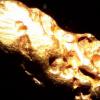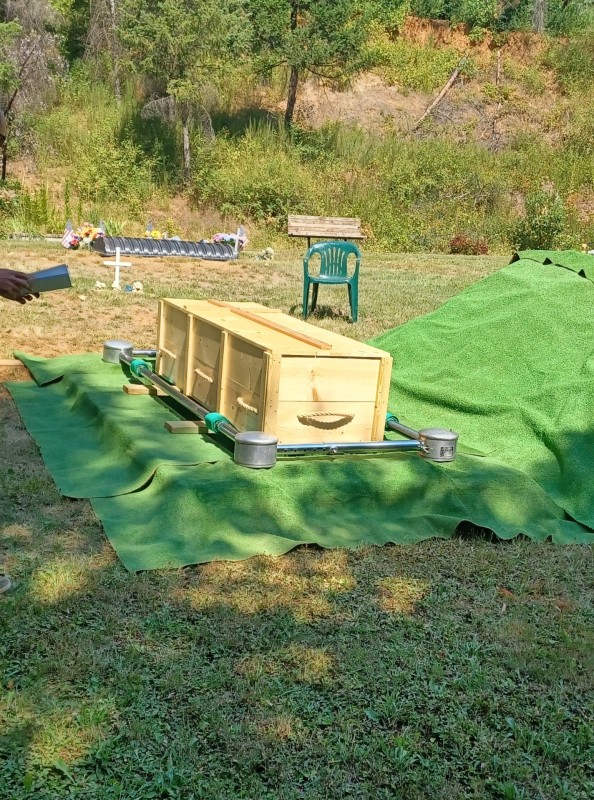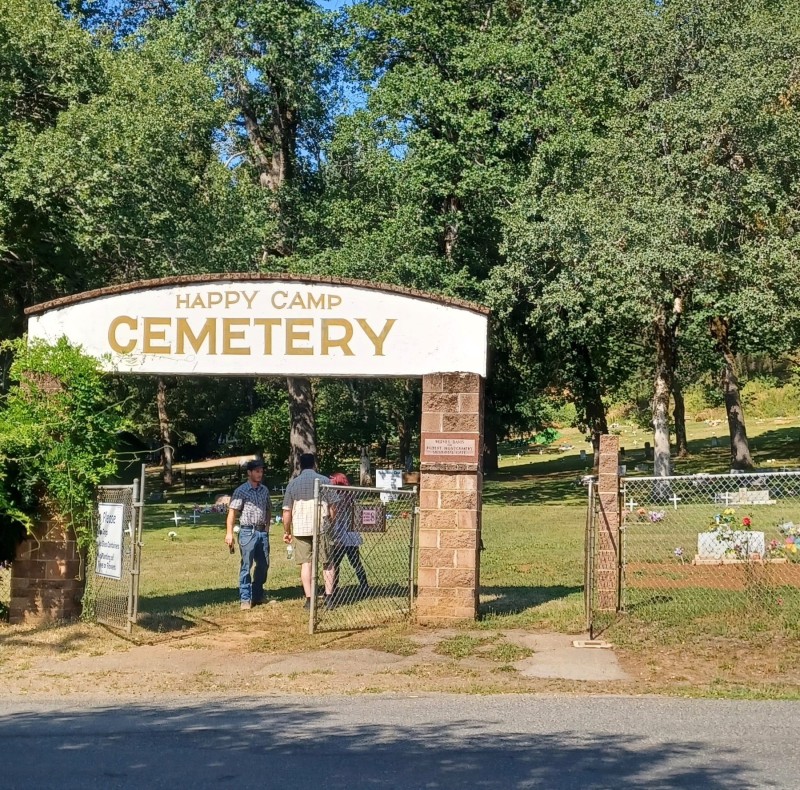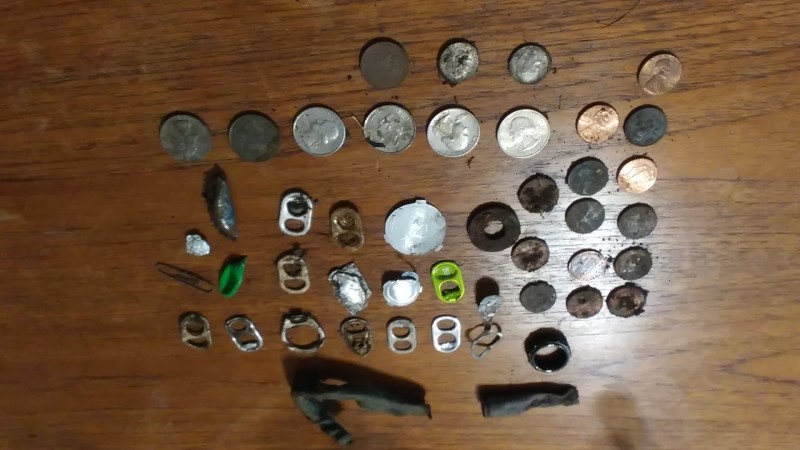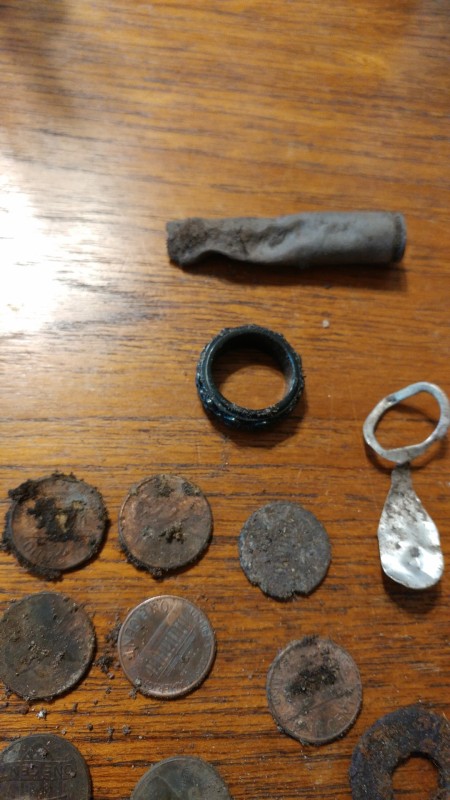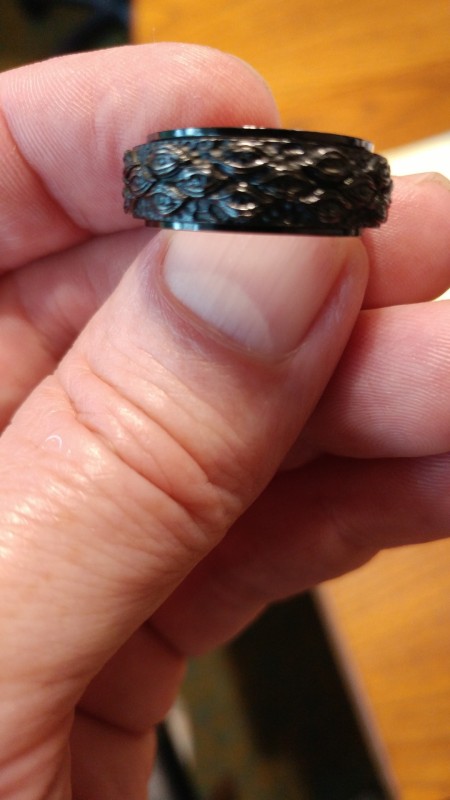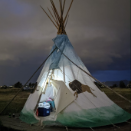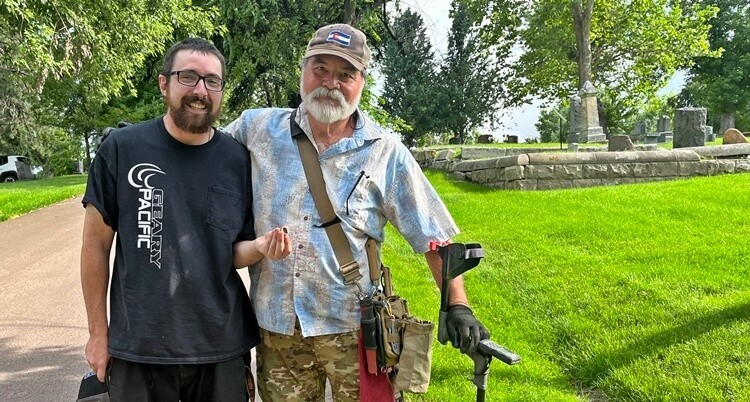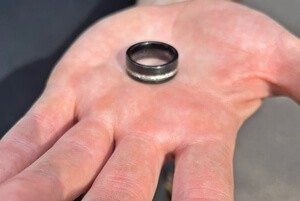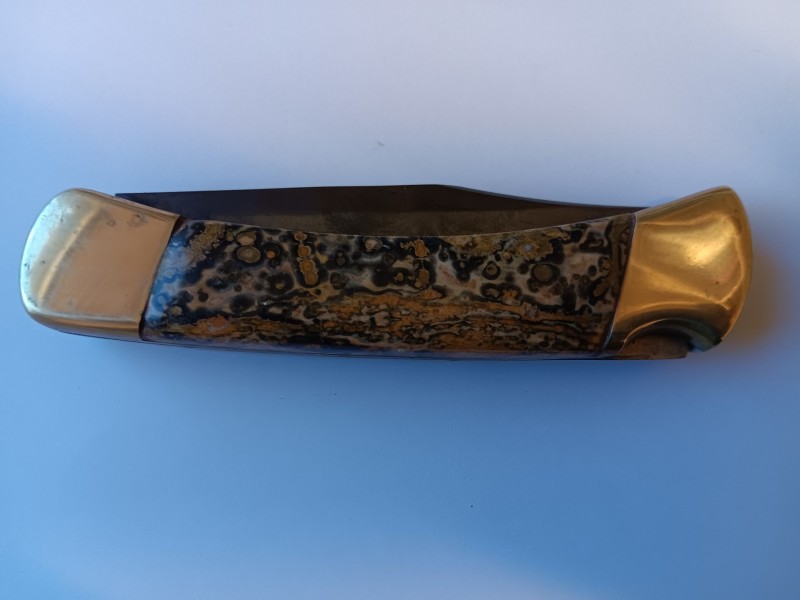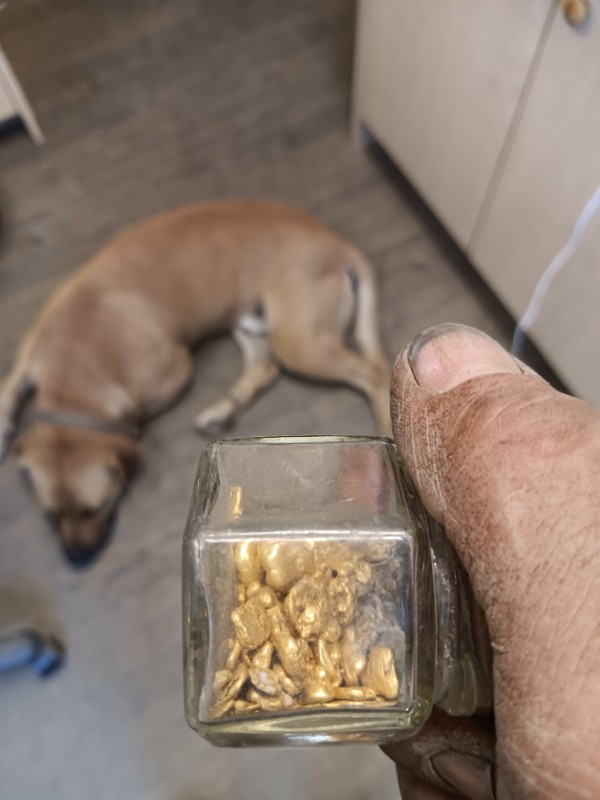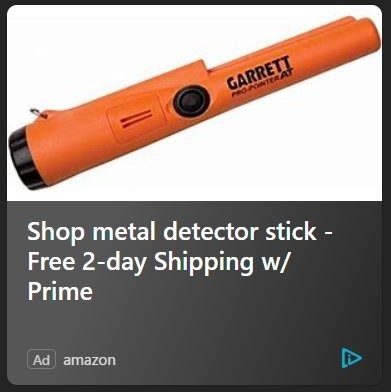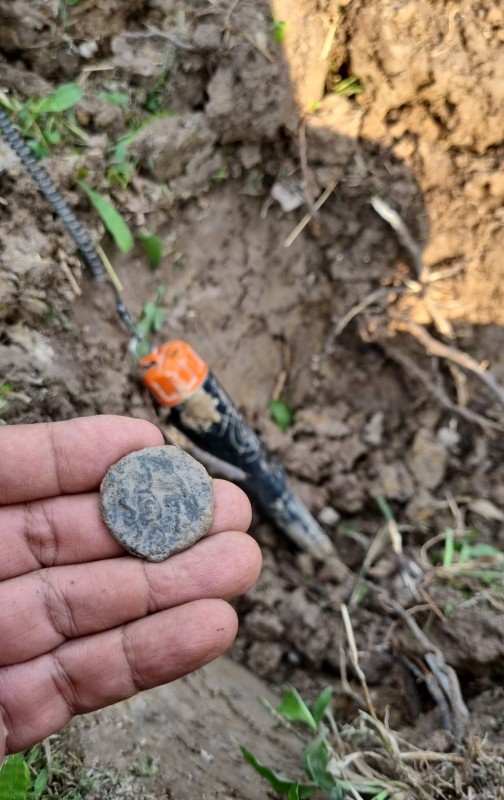Leaderboard
Popular Content
Showing content with the highest reputation on 08/07/2023 in all areas
-
Hello all. Jim would be humbled by the kind words and comforting sympathies for him and to his wife Linda on the forum. I traveled over the Klamath / Siskiyou mountains yesterday for the graveside service for Jim Foley. It’s about 100 miles from my house to Happy Camp, providing a quiet early morning drive through beautiful country, allowing me to remember Jim. It was comforting. Jim was laid to rest towards the top of a gentle slope overlooking the small local cemetery in Happy Camp, Ca. It was a small ceremony with folks from his church in Yreka, his family, including wife Linda, daughter Nicole and husband, son Jim Jr. and 4 fellow prospector/miners. The simple casket was made by a friend out of local pine with natural rope handles and a cross on top. Six of us unloaded the casket from the back of a pickup and carried it to the burial framework. Family and friends spoke fondly of Jim and his life. Some fine recollections were said about his mining/prospecting in Alaska as well here in northwest California. The minister then spoke of Jim and his commitment to his church and faith. It was really nice, informal. Dave McCraken and I were chatting quietly as we all gathered around the casket. I said to Dave, “ look at that pile of good red dirt from Jim’s grave, what do you think?” Dave says, “well, it’s hard to tell, you can’t see the grey layers where the gold would be with it all shoveled into a pile like that.” We were kinda smiling at each other when a young man sitting with Jim’s family (son in law) said, “what do you guys think, paydirt?” Like I said, it was real nice, Jim would have liked all of it. Mike21 points
-
RIP Jim. If there wasn't any gold in that dirt, there is for sure a piece of gold in it now!9 points
-
The 'AFFIDAVIT OF ANNUAL ASSESSMENT WORK" (Form 3830-004) is not a mandatory form and isn't sufficient to meet your State's Affidavit requirements. The ONLY required mining claim form is the Small miners Waiver 3830-02. Every other BLM form is "optional" and has this buried in the details: This 'AFFIDAVIT OF ANNUAL ASSESSMENT WORK" (Form 3830-004) form does not meet any state's requirements. Your State's laws determine what a valid Location Notice/ NOITH/ Affidavit consists of - NOT the BLM. I would VERY STRONGLY SUGGEST that you never use any of the BLM forms but the federally required Small miners Waiver 3830-02 form. For the other BLM "forms" follow your State's requirements and make up your own or use the form offered by your State if they have one (most do). Any of the required filings with the BLM but the Small Miners Waiver can be submitted in any way you want as long as they meet the basic legal requirements. Writing it out by hand on a plain piece of paper is adequate if it's readable. You will find those legal requirements in your State's statutes governing mining - not the BLM or Federal regulations. Here are the legally required Affidavit of Labor and NOI requirements in Arizona : A. Before December 31 of any year in which the performance of annual labor or making improvements or the payment of claim maintenance fees on a mining claim is required, the person on whose behalf the work or improvement or payment was made, or the person's representative, knowing the facts, may make and record in the office of the county recorder of the county in which the claim is located an affidavit of annual work or an affidavit of claim maintenance fee payment. B. The affidavit of annual work must state in substance the following: State of Arizona, county of ____________________ ss: _________________________________, being duly sworn, deposes and says that: I am a citizen of the United States and at least eighteen years of age. I reside at ____________________, in _________________ county, Arizona. I am personally acquainted with the mining claim known as ___________________ mining claim, situated in _________________ mining district, ______________ county, Arizona, the location notice of which is recorded in the office of the county recorder of that county at [county recorder information]. Between the _____________ day of _______________, _________________, and the _______________ day of ___________________, ___________________, at least _________________________ dollars worth of work and improvements were done and performed on the claim, not including the location work of the claim. Such work and improvements were made by and at the expense of ___________________________, owners of the claim, for the purpose of complying with the laws of the United States pertaining to assessment or annual work, and _______________________________________ (here name the miners or persons who worked on the claim) were the persons who are employed by the owner and who labored on the claim, doing the work and improvements as follows: (Here describe the work done and add signature and verification.) C. The affidavit of claim maintenance fee payment must state in substance the following: State of Arizona, county of ____________________ ss: _________________________________, being duly sworn, deposes and says that: I am a citizen of the United States and at least eighteen years of age. I reside at ____________________, in ___________________ county, Arizona. I am personally acquainted with the mining claim known as ______________________ mining claim, situated in __________________ mining district, ______________ county, Arizona, the location notice of which is recorded in the office of the county recorder of that county at [county recorder information]. A claim maintenance fee of _________________________ dollars was paid by or at the expense of ___________________________, owners of the claim, instead of recording an affidavit of annual work for the purpose of complying with the laws of the United States and holding the claim. (Here add signature and verification.) As you can see the BLM form doesn't cover most of the legal requirements in Arizona. You will find similar but different requirements in each state. To keep your claim valid and current you must follow your State's legal requirements.5 points
-
I figured if i found even one nickle i would have done good , but went above my expectations, and found 6 quarters two dimes,and one nickle, and a ring, that I think is stainless and it spins, Not shown are the 5 pop cans i dug out from the depths and some iron , I like to clean out the parks I hunt , I will keep removing the cans until they are gone , then everything will be right on the top when lost I was using the Bounty hunter Tracker 4 a good park detector4 points
-
Short Answer, Chuck: Yes it does apply from one VLF to another and I would add from one detecting objective or environment to another. It can be counterproductive if you blindly apply “knowledge” gained from one VLF detector to another VLF detector without thinking about the inherent differences in the way features are implemented between VLF detectors or their different behaviors, strengths, and weaknesses. Similarly, it can be counterproductive to have the mindset that one’s approach and knowledge gained by specializing in one type of detecting (e.g., relic hunting) would translate wholesale and directly to beach detecting or gold prospecting. Relatively mundane techniques such as the methods and tools used to recover targets varies greatly. If you don’t know how to use a heavy duty water scoop in heavy surf you will have little success even if you have nailed the detector language telling you there is a gold ring under your coil. The Nox to Manticore sensitivity and recovery settings “disconnect” is now becoming more obvious, but it definitely existed with Deus and Deus 2. A lot of Deus “unlearning” was required for me to truly unlock Deus 2. Furthermore, the way you use a single detector model varies greatly depending on your detecting objective and environmental conditions. As an example, one may be a wizard with the Nox at beach detecting or coin shooting but may struggle mightily relic detecting in hot ground or gold prospecting with the Nox because even though the Nox is capable of tackling all those things the setups and techniques used are completely different, such that if you solely use your beach or coin shooting knowledge and fail to recognize that the environmental or target type differences require a completely different setup or technique, the Nox will “appear” to you to be ill suited to the task, when it is your “old” or non-applicable experience and knowledge holding you back. Individual “common” features such as ground balance, noise cancel, sensitivity, discrimination, tones, recovery speed adjustments, frequencies, pinpointing, and “modes” behave very differently with respect to these parameters from one VLF to another, even within the same brand or even model family, and sometimes, in the case of Deus 2 and Manticore, within the same detector, itself. On Deus 2 there are basically three groups of modes which behave differently from the others. The terrestrial “discrimination” modes (General, Sensitive, High Conductor, and Mono) are pretty different from the three Beach/Dive discrimination modes, and the “non-discrimination” Gold Field and Relic modes are vastly different from either of the other two “discrimination mode” groups in terms of behavior, tone, and available settings. Even the notion of “All Metal” varies from one detector to another. In one case it can mean simply removing all discrimination, in another it is the true raw unprocessed IB signal (motion or non-motion), in another it is a specialized mode that processes signals different than the “discrimination” modes (Deus and Deus 2), and in others it disc and all metal (or motion and no motion) can be implemented simultaneously (e.g., Tarsacci) to simultaneously provide mixed audio to the detectorist. I tend to learn each detector’s language, quirks, features, and weaknesses individually, uniquely but I don’t consider this “diversity” in detector-to-detector behavior a hindrance, but rather it is the essence of what I mean when I say one detector “compliments” another. To this point, my experience with a Deus detector that had multiple frequency settings multiple reactivity/recovery settings, and multple search modes made Nox less intimidating to me, so in that sense the prior knowledge and experience using a versatile "Swiss Army knife" type of detector was helpful in getting a running start with the Nox, but the Nox also had its own language, which I had to force myself tl learn and avoid the temptation to revert back to my comfort zone with the Deus. So, of course there is a certain degree of knowledge and technique “crossover”, but if I have really learned a detector well, then my brain and muscle memory actually take over to switch my “operator’s mode” over consistent with the detector I am swinging. My detector setup, settings and techniques differ depending on which detector I’m using even if my detecting objectives haven’t changed because the detectors themselves have different behaviors and different strengths and weaknesses. Even when using a single detector, I often “interrogate” iffy targets by hitting them with different modes or even different setups of the same mode (by varying a single or multiple parameters such as frequency, recovery, disc, or tone). This used to be accomplished in a less straight forward manner by hitting a site with two or more detectors that operated at different frequencies or that had different recovery speeds or discrimination behaviors. When switchable single frequency, simultaneous multifrequency (SMF) , and finally the Nox with its combination of multiple SMF modes and multiple switchable single frequencies came along, you now could hit a site just a few times with the same detector but with different mode setups and accomplish that same feat that you accomplished with multiple detectors and multiple passes through a site. Bottom line is that there are general experiences and knowledge and basic setups and techniques that you can carry over from one detector to the next or one detecting objective or environment to the next, but there is also a greater amount of specialization and “unlearning” required, as well (which I refer to collectively as “evolving”). Especially as the detectors themselves evolve into more capable, versatile, and complex machines.4 points
-
I have been thinking about all of the testing I have done. It makes me lean to running your Audio Response high 6-7 and controlling the detector with sensitivity. Even in my black sand conditions I find Audio response is not the lone culprit when looking at stability. Depth was affected by both sensitivity and Audio Response. It would be nice to see a good test garden example of a lower audio response beating a high audio response in ANY condition.3 points
-
The reason I am wanting the mineralization meter is not for ground balance— the machine tells you when it is off. It is the recovery speed that in my experience is hugely affected by different types of ground. —BUT —- the trouble is (at least for me) there is no indication that you are not hearing the good signals as being good, but rather just a bad sounding trash type sound. HOW EVER— if you change the recovery speed up or down 2 or 3 clicks these targets scream at you as great targets. The differences in mineralization from place to place is a silent killer of signals For me this is the big hurdle I MUST learn to overcome. RSmith3 points
-
Seller has agreed to send two replacements. Doesn't want the old displays back. Will report back when they arrive.3 points
-
My hunting buddy, Richard,( @walkerrj ) is a member of Ringfinders and he lets me tag along on some of his recover missions. Last week he told me, "We have amission and it's a strange one! Are you in?" "Well of course!", I replied. After all, many ring recovery missions can be strange. We did one in the mountains where a lady lost her wedding set in or near a chicken coop after a snowfall. That was fairly strange. We found that one, BTW. So how strange could it be? He then told me the ring was lost in a local cemetery. Okay, that's probably up a level on the strange meter. Luckily I know the cemetery manager, having installed security cameras in the small chapel there. So late in the day a few days later, we met up with the young man who had lost his wedding ring while visiting his mother's grave. We had to meet him after he got off work and when we got to the cemetery the office was closed and it was just an hour or so until the cemetery would be locked down for the night. So off we went to see what we could do to help the young man. We asked him when he had lost the ring and if he had an idea where it may have come off. He said it had been a week earlier and the was an area about half the size of a football field. Well I was hoping this would be a fast recovery without any unnecessary digging for obvious reasons. We split the area in half and Richard took the mother's grave area and I took the area along the road heading from where he had parked the week before. Well about 15 minutes, 2 bullet casings, and a lug nut later, I hit the black Tungsten band barely visible under the deep grass. Needless to say the young man was very happy to have his ring back and said his wife would be very happy as well because she had engraved a special message in it for him. So the ring was recovered, the guy was happy, the wife was happy, and we were happy too. Of course, as many of you know, the feeling of returning a ring never gets old, but we were also happy we got it done in time so we didn't have to spend the night in the cemetery! 🏛️👻3 points
-
Yeah, that looks like a faulty display. It's good to know there might be a direct replacement. When Sharp obsoleted that display we looked for a replacement but there was none at the time.3 points
-
In the late 1800s, archaeologists discovered an arrowhead at a Bronze Age dwelling in Mörigen, Switzerland. In the years since, the 3,000-year-old artifact has been part of the collection at the Bern Historical Museum. Now, a new analysis reveals that the object is no ordinary arrowhead — it was crafted from a meteorite that crashed to Earth 3,500 years ago, according to a study published in the September issue of the Journal of Archaeological Science. Meteorite that crashed to Earth 3,500 years ago carved into arrowhead by Bronze Age hunters | Live Science3 points
-
Disclaimer: long read. I spent several hours with the Manticore in the goldfields in the high Sierras and thought to provide some insights and impressions. First of all, the purpose of the Manticore for me is the ability to hunt for gold nuggets in really trashy mine sites. As you know, the Sierra Nevada has been visited by a few gold prospectors before (🤣), and prospecting at popular mine sites without any form of discrimination, that is based on target IDs, is pretty much hopeless. Sometimes, digging up everything with PI/ZVT is possible if you take on a really submissive mindset, but it is for the most part highly unproductive and will make your day nothing else but miserable. I tested the Manticore with the sole purpose of finding gold in trashy and highly mineralized mine sites, and by using various test nuggets ranging from 0.1 to 0.4 g. What ended up working best for me was: Gold Field mode with Prospecting audio theme, treshold 17, pitch 22, volume 14, sensitivity 16, revovery speed 6. The 0.1 nugget gave IDs between 8 and 12 and the 0.4g nuget around 22. Of note, the y axis on the screen( ferreous potential) is pretty much useless for detecting small nuggets, and both nuggets consistantly showed up at the upper and lower boundaries, unless right under the coil (then also in middle). So, don't trust the ferreous paramter when you hunt for small gold. When you detect a repeatable target, swing over it several times from different angles with short swing range and slow speed. In particular with the 11 inch coil, the target ID can be all over the place if the coil picks up too much ground signal as you move over the target of interest. So, make sure your "drill down" swings are tight. This should get better with the smaller coils, but for the 11 inch coil you need to be tight. Despite auto tracking on, I have not noticed that targets were tracked out. So, it's ok to take your time and examine a target from various angles with several swings. Importantly, the IDs should remain tight when you do that, like.+/- 3. Too much of variations can indicate hot rocks, which generally showed up for me in the 27 range, but can also be as low as 2. Often, the hotrocks give a slightly elongated trace in the very upper ferreous region of the 2D screen. This was pretty consistant, but might depend on the hotrock composition of the area. Again, don't look at the ferreous indicator when you suspect a nugget, it may or may not work and will fool you often. By far the most impactful parameters are sensitivity and recovery speed. In mineralized ground, the 16/6 setting worked the best for me. Anything above sensitivity 16, or max 17, or recovery speeds below 6 made the machine totally unstable and practically useless. If your ground is alot milder, you might be able to dial up the gain (or dial down the recovery speed), but this will highly depend on your conditions. I can just say that if some sort of ID is important to you, then you MUST tame the machine down, in particular in hot ground, otherwise all benefits of target ID will go away quickly. Under these conditions, the depth is only modest with the 0.1 nugget disappearing beyond 1-1.5 inch depth. To be able to detect at the edge, you need to keep the treshold on and listen for slight wispers (often without any ID dispalyed). This is absolutely essential to get some sort of depth, and this has not changed since the earlier VLF days, despite all the modern advancements. For the "full bore enthusiasts", this might work for PIs if your brain can handle it, but will NOT work for the Manticore, or any other VLF that I have used for that matter. If sensitivity is too high, you will not hear a nugget even when it is directly under the coil. So, be warned, as the Manticore has alot of power to offer. Do frequent GB and noise cancel, this helps, albeit not as much as for the 6000. I actually like the pinpointer feature, but the hotspot is at the tip of the coil, not at the center which I believe the manual says. Overall, the Manticore is a great machine for my purpose, but you need to find the sweet spot in settings to maximize the target ID quality for digging less trash, and to have a chance for a succesful day at a mine site. The depth and sensitivity under these conditions are modest at best, with depths detectable down to 2-3 inches for the 0.4 g nugget and about 1 inch for the 0.1 nugget. However, then with mostly reliable and consistant target ID numbers. There is absolutely no comparison to the 6000, which in this soil and under these conditions beats the Manticore by a huge margin, as expected. In mild soil this difference could shrink, but for sure not where I hunt. However, the 6000 is totally unproductive in highly trashy areas and the Manticore can save the day. So, gold can be recovered at super trashy sites with the Manticore, but expectations need to be managed. GC2 points
-
Just wanted to say Hello to all the Detectorists out there. My name is Kevin & I am located in NW Illinois. I am a member of the Illinois & Iowa Treasure Hunting Club and have been detecting for about 7 years. I am a Minelab user... I have an Etrac, CTX 3030 & a Equinox 800. I am mainly a coin shooter with interests in relics. I am not big on parks unless they are no longer in use but still survive in a corn or bean field. I am always on the look out for forgotten picnic groves. My oldest Silver coin is a Capped Bust half dime (1829) and My oldest coin is an 1828 US Half Cent. Happy Hunting Kevin2 points
-
2 points
-
While sad that was nice. Thank you. To think I asked of Dave McCracken.... & there he was. Fare well Jim. RIP. You are in gold country D4G2 points
-
Uh, did you forget the (dead) mother? Just to be extra cautious, I suggest that you not go back to that cemetary, CPT_G....2 points
-
I was not talking about ground balance specifically, though that’s part of the puzzle. Like I said, you should be able to determine how mineralized the ground is simply by how the detector behaves over the ground. A mineralization meter is redundant for me, not telling me anything I don’t already know. But hey whatever makes people happy, and if having a mineralization meter makes people happy, I’m all for it. 👍🏼2 points
-
Trying to sub a color display is tricky. Did you compare the data sheets to make sure the flex tail pinouts were the same, and that the timing was the same? The fact that the sub works at all suggests they are very close, but the black bars may be due to a timing difference.2 points
-
Ultimately I e always found a mineralization meter redundant to how I tune. I start with powerful settings that back down until the machine settles enough to satisfy me. Where that will end up being depends on the mineralization. I can get way with more aggressive setting in low mineral environments, and have to back off in tougher ground. They way the machine reacts “talks to me” and tells me what to do. The machines I’ve had that had the meter I eventually never paid much attention to it. What I far more prefer is good overload function that tells you the machine is set too high for the ground. My 24K will complain loudly if I set the sensitivity to high. Back it down one step, I’m set. Can’t get more dummy proof than that. There hav been detectors that go into “silent overload” and appear to be working when in fact they have pretty much shut down. Bad news for those unaware of it. But unlikely for people that don’t hunt the really bad ground.2 points
-
2 points
-
I recently spent a couple of days with ---- ----- ----- and ------ at the famous ----- ---- mine in ------- county, California. We all found some nice gold, but I found a bit more because I was willing to dig a little bit deeper. The gold was mostly in a strata of ----- ---- rock and was very course and there were few small bits, even using a 6000 to check behind my 7000. If any of you should go there be advised to say to the left when you get to the --- ----- ----- or you will definitely get stuck for hours, and if you camp out be sure to ---- - ----- ----- because there are numerous -------- and ---- --------- teeth and will tear you apart with there claws. Oh, by the way don't try to get to the mine by going -- --- ----- ----- as the map is incorrect and you will ---- ---- ------- and there is no place to turn around1 point
-
1 point
-
No leaking here yet and mine is submerged at least 4 days a week. I have owned quite a few "water" detectors, including the Nox and sooner or later all were sent in for some sort of repair, but none for a leaking issue.1 point
-
At the moment I have a Quest Xpointer Max : iron disc and lithium battery , it is an excellent pinpointer, no need to change for a new one .. Or perhaps for the new version when available Apart from this the Sphinx03 is not available in France , at least not available at the main French detector dealer( Maison de la detection - Paris ) : Pinpointer - La sélection des meilleurs Pinpointers de détection (maisondeladetection.com)1 point
-
abenson, Finally had the time to watch your "comparison" video between the original version, and the update, over the three targets. Nicely done. Very informative. Steve1 point
-
Thanks Jerry, The chain came out just as you see it. The ring was a recent drop as well but I did polish out the numerous scratches. I went out again yesterday and it was my worst hunt in a long time. Looking forward to some hurricane season swells.1 point
-
1 point
-
BLM has the "AFFIDAVIT OF ANNUAL ASSESSMENT WORK" (Form 3830-004) expired as well. County Recording Due by September 30th. Not Good!1 point
-
The best I can do is a schematic for the RB5, which was the middle sister in the RB family (RB7/RB5/RB3). It should be very close to the RB7 circuit as there were only minor differences in the machines. With only a quick look, I'd say the burned transistor is Q115 which regulates the +8V supply. You can replace it, but there may be another problem downstream that caused it to burn. And, yes, it uses 2x12V AA battery packs, easily found online. BH_RB5.pdf1 point
-
Silver base it should id like silver on your machine, gold would be much lower in the aluminum range and gold that does not have copper in it or very small gold can be below a nickel. All the chains and chain pieces I have found have been in the foil range including chunky 10's Again do a scraping and acid test if it looks solid.1 point
-
I'm betting Nokta will surprise the "market" with their PI unit as much as they did with the Legend. They are very clever and capable on top of being attuned to consumer wants.1 point
-
It will react to the ground.. This is what I learn so far and in progress regarding sensitivity on my ground: 18-22 If I want to hunt pleasantly with Manticore tonal language experience and stable ID 23 to 25 the language get distorted kinda and the ID still can be use as reference 26 to 29 back to basic dig or no dig tonally and just to check if something down there or not. Manticore tonal language will be thrown out of the windows when I use this setting.. lol1 point
-
I hope Minelab makes an exception for the Manticore. Its a usd 1500 detector and as @Yatahaze323pointed out a usd 250 detector has one. I feel the mineralization's meter will be very helpful tools to determine quick initial/rough setting to get the maximum performance, but then again what do I know.. lol. Yesterday I'm on a site of which within 25m radius I get 3 different GB reading of 2, 10 and 42. I don't know what kind of mineralization's are but I do test at 1 spot I can only detect 7' deep and the other 2 spot around 10' to 14' by using AT General. The site were in palm oil plantation near a river with clay soil. At all these spot the deep targets cant be detected using below 21 sensitivity. This coin in particular were found at 10' ish, The lowest setting it can detect ( with no ID, no trace just very faint whisper sound ) is sensitivity 22 with recovery of 4, using recovery of 6 the target disappear. The 'ok' setting that still has the Manticore tonal language is sensitivity of 24 with recovery speed of 4. The good the basic 'dig me' tonal setting for me is sensitivity 27 with recovery speed of 5. I'm for one is happy with the Manticore 35 sensitivity range is available to me. It is very helpful to check very deep targets. It is a tin coin leaching for 300 years in the ground. I didn't use any other modes to check.1 point
-
Right, AR doesn’t technically reduce the depth of the detector, but it does reduce the depth the detectorist can hear a target.1 point
-
Welcome! Lotsa good stuff on this forum for anybody that swings a detector and whatever method one chooses for seeking gold. Good luck! HH Jim Tn1 point
-
Can you get a Sphinx 03 France? deeper discrimination and no 9v battery.1 point
-
I sent in the old Small Miners Waiver form and Phoenix office accepted it. But I will keep watch to see if they post a new form before August 31st. They are putting us into a bad situation due to their own negligence. -Don1 point
-
I bought one of those RB7's when they first came out, wow, was a fantastic coin machine "for its time", fluid swing action for the coil with that new "motion detection", and I was getting handfuls of silver coins at my local park with it, way more so than the latest Whites coin machines of the same "vintage", and I had em all. But the RB7 was shortlived since it had limited depth, of 5-6" depth on most coins and it took faster swings to get more depth, that was annoying as well. I did have a lot of fun with that machine. Soon Whites blew them all away with slow motion as well as 9-10"+ depth on coins and deeper. As well as superb ID which to this day no one has been able to copy.1 point
-
Good question. Jacob was convinced it was the exact same area of the strike of 1937. Now we are talking about a vast area 65 yrs later and an 85 yr old man who's memory had faded as anyone's would after all that time. The line of pay streak out in that area is about 3/4 of a mile in length and goes way back into the mountain for hundred or maybe thousands of feet. I think in this case we had hit yet another honey hole that Jacob was calling his old strike. We never argued the point because gold is gold.1 point
-
Here's a link to the "The New 49ers" website/new letter, on that page is the latest New Letter...August 2023, if there' any new what Dave is up to it's probably is in that new letter, or there's also a link on that page to their Facebook page. https://goldgold.com/newsletter-august-2023.html1 point
-
The funny thing is even if Minelab’s Amateur-Find 40 is their claimed 10% deeper than the 35 all that would do is catch it up to the worst performers in the bunch 😂1 point
-
Here's the links to the story of the Frolic.. https://pointcabrillo.org/learn/history/frolic/ https://pointcabrillo.org/learn/history/frolic/frolic1850/1 point
-
They read. They never, NEVER respond on social media. You got their response which is that they are acknowledging the requests. They will either take action or not. In my experience Minelab considers the update function a way to issue bug fixes, not a way to add missing features. That would normally happen in a new model, say a Manticore Pro, or a CTX 4040. But if they did decide to issue it as an update to Manticore, they sure won’t say anything about that until it actually happens. It’s not as trivial to do as you might think, and a promise just sets them up for constant complaints of “why has it not happened yet.” They won’t tell you when the coils will release so why would they tell you this? With Minelab it’s believe it when you see it. Like it or hate it, it’s the way they roll.1 point
-
klunker, very informative, did not expect that degree of specific information, thanks for sharing.1 point
-
Now you are in my wheelhouse! Good work. You need to go back soon!1 point
-
The build of the two is very different. The Deus 2 is just a stand-alone pod, attached by a mount. The Equinox and Manticore is an integral mount including handgrip. Much more inches of seam to fail in the Equinox/Manticore design!1 point
-
I can only repeat so many times that the Manticore at 1/2 to 3/4 settings is like a maxed out Equinox. The Manticore has extra headroom, but only for locations and situations that allow it. Anyone with a mindset that they can drive a Ferrarri with the pedal mashed to the floor anywhere all the time is going to crash and burn with Manticore. It is imperative that people back it down and then work their way up. Again, target ID stability is a great tool for determining when you have good settings, and above that, well, yeah, it's going to get squirrely. I was swinging this machine before anyone here even knew it existed, probably before Tom D. I'm not just opinionating - I'm trying to help you all out with this. But nuff said, good luck!1 point
-
1 point
-
An expedition !?! NOW you have everybody's attention , an ancient place is absolutely the best place to be detecting for anything ! Keep us posted on any finds , and we DO like pictures . Not just finds but the site you're detecting would be very interesting too . Looking forward to hearing from you again soon ! Good Luck1 point
-
The scaling idea I proposed could be applied to the "% magnetite" scale in the same way. It would probably be better to change from percentage to 'ppm' , parts per million, then it would give large non-fractional numbers to deal with. One percent = 10000 ppm, so choose '40' to represent this. This results in readings: 88-display = ppm = % magnetite 46 = 40000 = 4 44 = 25000 = 2.5 42 = 16000 = 1.6 40 = 10000 = 1 ... 30 = 1000 = 0.1 ... 24 = 250 = 0.025 22 = 160 = 0.016 20 = 100 = 0.01 18 = 65 = 0.0065 16 = 40 = 0.004 I've investigated what the magnetic susceptibility figures are. Thanks to a wiki page on Magnetic Susceptibility, I see the issue. https://en.wikipedia.org/wiki/Magnetic_susceptibility Magnetic susceptibilty is in fact a dimensionless quantity, it has no units, regardless of whether you're using standard SI metric, non-standard/obsolete metric, such as cgs, or even Imperial measures. However, what I hadn't realised was that SI metric (which I'm familiar with) and cgs metric treat magnetic fields and their effects on things differently. This causes the magnetic susceptibility values to be scaled differently. They're both dimensionless, but the values will be larger in one unit than the other, by a fixed amount. This ratio turns out to be (4 x pi ). SI metric susceptibility = ( 4 x pi ) x cgs-metric susceptibility Rather odd... So .. what Fishers "2500 micro-cgs" means is: 2500 x 10-6 units, in the cgs metric system, equivalent to: 31416 x 10-6 units in SI-metric. The problem with the two scales, "% magnetite" and "susceptibility", is they don't accurately relate to each other, as there's different types of magnetite, with differing susceptibilty. A commonly stated 'average' is 6000 x 10-3 in SI metric, but it can vary from 1000 x 10-3 up to 20000 x 10-3. The figures Fisher have used assume a value of 3142 x 10-3. ( 1% magnetite == 2500 x 10-6 [cgs] = 31416 x 10-6 [SI], hence 100% magnetite == 3142 x 10-3 [SI] ) As susceptibility is a precisely defined quantity, whereas % magnetite is variable, it would be best to scale any meter to susceptibility. Here's some background reading on magnetite and it's magnetic characteristics: https://www.eoas.ubc.ca/courses/eosc350/content/foundations/properties/magsuscept.htm1 point


